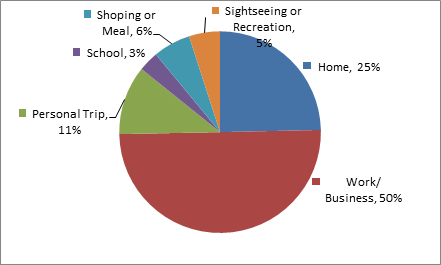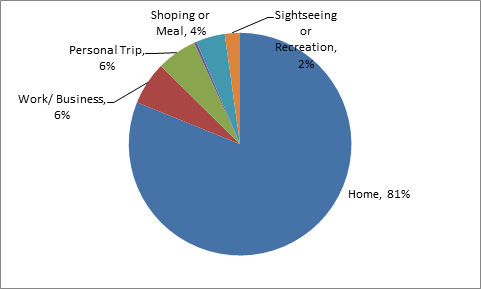When Work Evolves – Metrorail in the Era of the Flexible Workplace
Between 2007 and 2012, off-peak work trips were the fastest-growing segment of Metrorail ridership.
The traditional “rush hour” remains important, but Metrorail ridership seems to reflect a broader trend regionally – people are making more and more trips during “off peak” hours. According to the 2012 Metrorail survey, rail ridership growth was stronger in its off-peak (8 percent since 2007) than the peak (5 percent over the same time period). In certain jurisdictions – including those that have fostered re-investment in dense, walkable areas – off peak growth was into the double digits while peak growth grew more modestly. In one jurisdiction, off-peak trips grew by 50% during this period while peak trips grew at less than half that clip.
| Compact Jurisdictions | Peak | Off-Peak |
| % Change | % Change | |
| District of Columbia | 8.3% | 12.9% |
| Arlington County | 18.4% | 9.0% |
| City of Alexandria | 9.5% | 12.7% |
| Montgomery County | 0.1% | 5.9% |
| Prince George’s County | -7.4% | -1.4% |
| Fairfax County | -1.4% | 3.0% |
| City of Falls Church | 21.3% | 46.9% |
| Fairfax City | 32.8% | 19.4% |
| Compact Total | 3.0% | 8.0% |
Data sources, Metrorail ridership surveys, 2007 and 2012. 2012 is the most recent dataset we have on trip purpose.
In the past these trips would be for theaters, late night entertainment, or shift work, but the bulk of these off-peak trips were during the midday – almost twice the number of late night trips – and the bulk of these trips were for work.

Mid-day trip purpose, source: Metrorail 2012 survey.

Evening trip purpose. Source: Metrorail 2012 survey.
What’s going on here? One explanation has to do with the changing nature of work. As more and more workers and employers embrace flexible working schedules (PDF)– including telework, becoming self-employed, or “hoteling” – working hours are less constrained by traditional start and end times. Work is everywhere, as are workplaces (from shared office suites to coffee shops to on the Metro system itself), and getting to work midday after a morning run or yoga class is not only chic, but par for the course for an enterprising urban professional.
This means that Metro – and the rest of the region – has to get away from the notion of “rush hour” as a constrained period of time. Rush hour is every hour, and those in the business of providing mobility to the region’s workers now must find creative solutions for all-day capacity improvements and trip-making ability for workers that are no longer working 9-5, but they might be moving 9-5.
Tell us, where and when do you work, and do you commute off-peak?


Lower labor force participation rate, between increasing amount of retirees and discouraged workers (unemployed and not looking for work) who have lots of time and not a lot of money (relatively speaking) who can choose to wait until peak charges turn off to take Metro for their non-time-sensitive trip.
Interesting idea, and one which I believe has some truth to it. I have seen folks waiting until off-peak fares are in effect before tapping into the system. Right now we don’t have data that suggests that there is a “surge” of these customers sufficient to account for the type of off-peak growth that the ridership survey suggested has taken place, but if you think this has been growing and have an idea for how we might quantify this effect, I’d love to hear it!
The long-range trend going back 20 years has been that mid-day ridership has grown somewhat more slowly than peak ridership, while evening and weekend ridership has grown much faster than peak ridership. From 1995 to 2014 (in May), weekday ridership grew 34.6% in the am peak, 21.5% mid-day, 33.4% pm peak, and 77.3% evening.
These trends suggest that non-work trips rather than shifting work schedules are the main reason for the growth in off-peak ridership. Another sign pointing in the same direction is the growth of reverse commuting. Where it’s convenient by Metro, it shows up in ridership – reverse commute trips have grown much faster than commuting into downtown. Where it hasn’t been convenient by Metro (e.g., Ballston to Tysons & Reston — am boardings at Ballston have dropped), you’ve had residents who drive to work but use Metro for personal trips replacing residents who took Metro into downtown and drove for personal trips.
Good stuff, Ben, and very nice piece on GGW yesterday. One thing to note about my post is that I’m reporting on customer surveys that include stated trip purpose. So, if a customer is telling us that their trip was for work purposes, the survey captures that. You can see from the pie charts in the post that the off-peak trips for work purposes seemed to grow over the 2007-2012 time period. I think that your longer view does capture the overall trip trends, but without specifics on the purpose of those trips, we can only intuit the purpose of those trips.
Are the Arlington numbers an anomaly or did you type them in backwards?
@Mr. Transit
Hey Steve. Nope – the Arlington numbers were typed in correctly. Remember that Arlington has the highest number of households out-commuting each day in the transportation planning zone we examine, so I’m not too surprised at what this says. Plus it has so many mobility choices for off-peak (or any time…) including walking, biking, etc.
Right now there is not much of a need for “all day capacity improvements”. Metro’s problem for the longest was the highly peaked nature of its ridership. Vast amounts of capacity sits or rolls along unused midday and evenings, particularly outside of the core. Take an inbound train from National Airport some weekday evening for example.
@Mr. Transit
to be honest, the big problem in all transportation is the “peakiness” of demand. The Beltway is pretty quiet right now (it’s Christmas eve for me!) but we didn’t build it for Xmas eve, we built it for weekday commutes! Ditto for airports, train stations, and subway systems. You’re dead on however, in that the region built this very nice rail network and then proceeded to use only portions of it. Take a train outbound TO Largo or Branch or Glenmont or Huntington (to name a few) in the AM peak and you can pretty much have the car to yourself. Sometimes an entire train. This is a function of local land use decision-making and our inability to think regionally about this asset – it’s costing everyone money to run empty trains, and since the current cost recovery on Metrorail is north of 70%, imagine what it could be if certain directions weren’t underused? Could WMATA run a surplus?
Stay tuned to find out – we’ve got more of this story coming. To whet your appetite, join us below…
https://planitmetro.com/2015/12/01/connectgreaterwashington-a-vision-for-a-responsible-and-prosperous-future-part-1-of-2/#more-12038
It’s good to see a ridership increase in the off-peak, which reduces the substantial negative effects of the “peakiness” of demand that you mention in the last post. In the case study of the transit system in Los Angeles that I conducted with my colleagues, the costs to provide one hour of service increase by more than 35% for bus and by more than 20% for light rail, including both the operating costs and the capital depreciation costs. In the 1994 when data for the study were collected, the peak-to-base ratio of the LA bus system (1.5) was one of the lowest of the major bus transit systems at that time. In 2013, WMATA Metro used 132 trains in the AM peak period and 68 trains in the midday; this gives us the peak-to-base ratio of 1.94. While I would not make an estimate of the % increase in the costs of WMATA Metro system only from these numbers, you can get some sense of substantially hire costs in the peak period, compared to the off-peak period for WMATA Metro system.
So it would be great to build up ridership in the off-peak hours and in weekends, as well as in both peak and off-peak directions, so that WMATA Metro system is utilized fully and more efficiently.
In regarding the effect of peak vs off-peak-fare differences, a simple idea is to check the number of people who are going through turnstiles within 5 minutes or so after 9:30am and 7:00pm and before 3pm (did WMATA decide to offer off-peak fares in the very early morning?) and compare to the number of people who enter within 10-15 minutes before 9:30am and 7:00pm and after 3pm for multiple days. What do you think?
@hiro
Fascinating info from LA. Without having a better understanding of their fleet and/or service plan, I can’t opine on whether there is an application to WMATA rail. Remember that our end-to-end train run times combined with scheduled policy headways dictate fleet deployment needs.
We’re all for advancing the cause for the Metrorail system to be better utilized at all times. Remember that the cost recovery on Metrorail is one of the highest in the nation and north of 70% to 75% (when excluding non-farebox revenues). Imagine what it could be if the system wasn’t sending empty trains east of the District every AM peak. That’s a function of local land use decisions (i.e. where jurisdictions choose to focus development efforts/economic development incentives) as well as the lack of regional cooperation on land use planning.
All of which we will be tackling this year in ConnectGreaterWashington. Keep tabs on our work on that effort here (https://planitmetro.com/2015/11/09/beyond-borders-acting-regionally-to-create-a-financially-sustainable-transit-system/)
sk